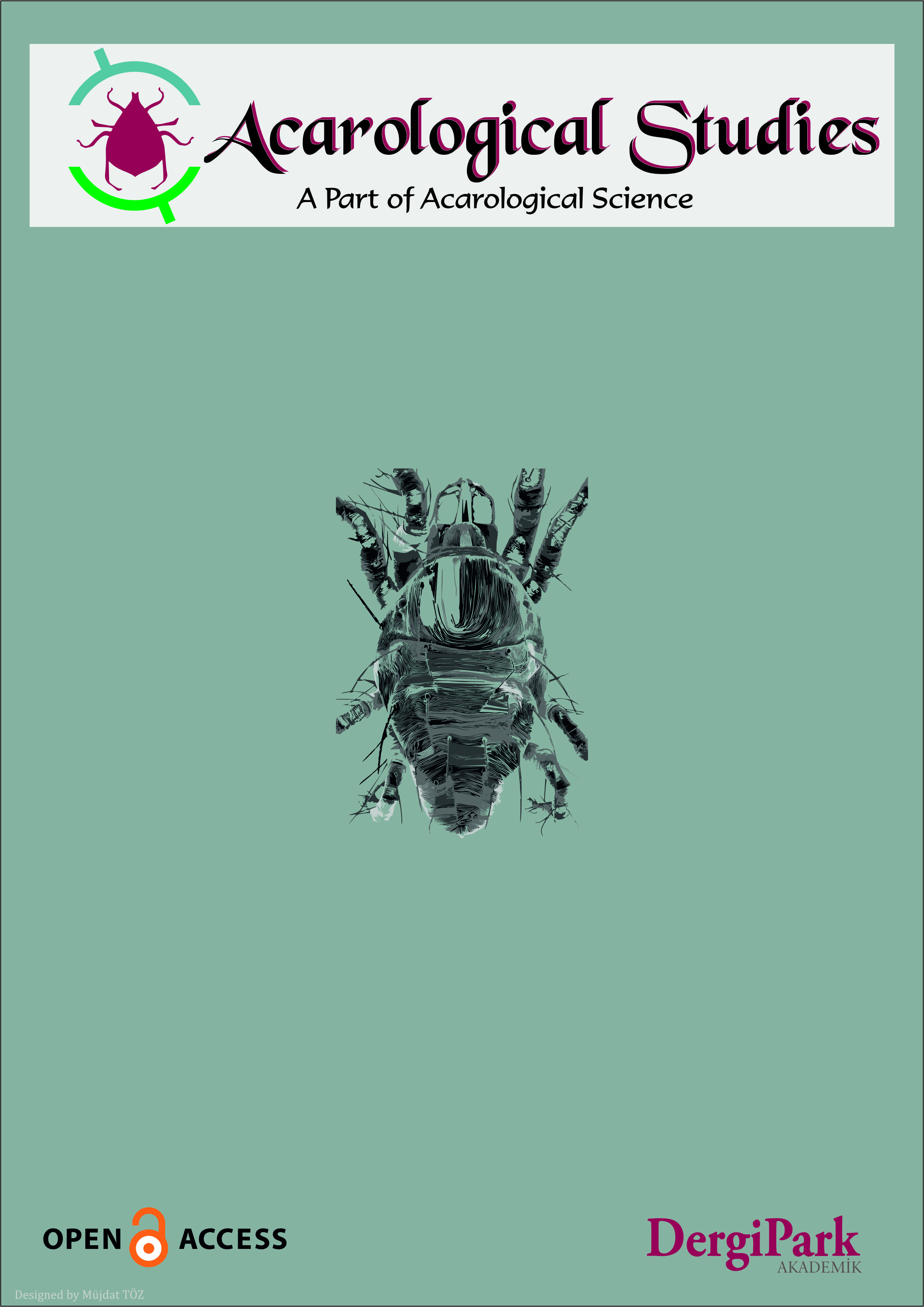Diversity and distribution of phytophagous and predatory mites on rosehip (Rosa canina L.) (Rosaceae) in Ankara, Turkey
___
- 5- Bayram, Ş., Ülgentürk, S. ve Toros, S. 1998. Ankara ilinde kuşburnu (Rosa spp.)’ da gal yapan böcekler ve bunların parazitoidleri üzeride araştırmalar, Türk. Entomol. Derg., 22(4): 259-268.
- 6- Chant, D.A. and McMurtry, J.A. 1994. A review of the subfamilies Phytoseiinae and Trophlodrominae (Acari: Phytoseiidae). International Journal of Acarology 20: 223–310.
- 7- Çobanoğlu, S. and Bayram, S. 1999. Mite (Acari) species associated with cultivated and wild rose plants in Camlidere, Turkey. Entomologist's Monthly Magazine, 135: 245-248.
- 8- Çobanoğlu, S. 2004. Phytoseiid mites (Mesostigmata: Phytoseiidae) of Thrace, Turkey. Israel Journal of Entomology, 34: 83-107.
- 9- Çobanoğlu, S., Ueckermann E.A. and Sağlam, H.D. 2016. The Tenuipalpidae of Turkey, with a key to species (Acari: Trombidiformes), Zootaxa 4097 (2): 151–186.
- 10- Demite, P.R., McMurtry, J.A. & Moraes, G.J. de. 2014. Phytoseiidae Database: a website for taxonomic and distributional information on phytoseiid mites (Acari). Zootaxa, 3795 (5): 571–577.
- 11- Dönel, G. and Doğan, S. 2013. The first record of a predator mite in kelkit valley: Zetzellia mali (Ewing) (Acari:Stigmaeidae). Fen bilimleri Enstitüsü Dergisi. Cilt:6, Sayı:2, 157-163.
- 12- Düzgüneş, Z. 1963. Türkiye’de yeni bulunan akarlar. Türkiye Bitki Koruma Bülteni, 3(4): 237-246.
- 13- Düzgüneş, Z. 1965. Türkiye’de bitkilerde zarar veren Tenuipalpidae Sayed familyası türleri üzerine incelemeler Ank. Üni. Ziraat Fakültesi Yıllıgı Fasikül 3, 120–148.
- 14- Faraji, F., Çobanoğlu S. and Çakmak, I. 2011. A Checklist and a Key For The Phytoseiidae Species of Turkey (Acari: Mesostigmata), International Journal of Acarology 37(sup1):221-243.
- 15- Jeppson, L.R., Keifer, H.H. and Baker, E.W. 1975. Mites injurious to Economic Plants. Univ. Calif. Press, 253–283.
- 16- Karaca, İ. 1956. Orta Anadolu ve Meyve Ağaçlarında Görülen Menşei Nebati ve Hayvani Önemli Urların Amili ve Morfolojileri Hakkında Araştırmalar. Ankara Üniversitesi Ziraat Fakültesi Yayınları: 84, Çalışmalar:45, AnkaraÜniversitesi Basımevi, 134s.
- 17- Koç, K. & Ayyıldız, N. 1996a. Türkiye faunası için yeni iki Raphignathus Duges (Acari, Prostigmata, Raphignathidae) türü. Turk. J. Zool., 20 (supplement): 209-214.
- 18- Koç, K. & Ayyıldız, N. 1996b. Türkiye faunası için yeni iki keyletid (Acari, Prostigmata, Cheyletidae) türü. Turk. J. Zool., 20 (supplement): 215-221.
- 19- Koç K. ve Ayyıldız, N. 1997. Türkiye faunası için yeni stigmaeid akarlar (Acari, Prostigmata, Stigmaeidae). Turkish Journal of Zoology, 21, 445-459.
- 20- Meyer, M.K.P. (Smith). 1987. African Tetranychidae (Acari: Prostigmata). Entomology Mem. Department of Agriculture Techechnical Service, Republic of South Africa, 69, 175 pp.
- 21- Migeon, A., Nouguier E. and Dorkeld, F. 2011. Spider Mites Web: a comprehensive database for the Tetranychidae. Trends in Acarology: 557-560, (http://www1.montpellier.inra.fr/CBGP/spmweb/).
- 22- Özbek, H., Güçlü, Ş. ve Tozlu, G. 1996. Erzurum, Erzincan, Bayburt ve Artvin illerinde Kuşburnu Bitkisinde Zararlı olan Anthropoda Türleri. Kuşburnu Sempozyumu 5-6 Eylül, Gümüşhane, 219-230.
- 23- Özbek, H. and Çalmaşur, O. 2005. A review of insects and mites associated with roses in Turkey. doi: 10.17660/ActaHortic.2005.690.25
- 24- Pritchard, A.E. & Baker, E.W. 1955. A revision of the spider mite family Tetranychidae. Memoirs Series, San Francisco, Pacific Coast Entomological Society, 2: 472 p.
- 25- Pritchard, A.E. and Baker, E.W. 1958. The False Spider Mites (Acarina: Tenuipalpidae) University of California Publications in Entomology Vol. 14 No.3, 175–274 pp.
- 26- Tuttle, D.M. & Baker, E.W. 1968. Spider mites of Southwestern United States and a revision of the Family Tetranychidae. TheUniversity of Arizona Press, Tuscon-Arizona, U.S.A. 143 pp.
- 27- Urhan, R. & Ayyıldız, N. 1993. Türkiye faunası için yeni bir Prozercon Sellnick, 1943 (Acari, Mesostigmata, Zerconidae) türü. Doğa-Tr. J.of Zoology, 17(1): 83-89.
- 28- Urhan, R. & Ekiz, A.N. 2002. Systematic studies on zerconid mites (Acari:Gamasida, Zerconidae) of Turkey. Acta Zoologica Academiae Scientiarum Hungaricae, 48 (3): 225-235.
- Yayın Aralığı: 2
- Başlangıç: 2019
- Yayıncı: -
A new species of the genus Neophyllobius Berlese (Acari: Camerobiidae) from Denizli province, Turkey
Nasir SABERI-RISEH, Alireza SABOORİ, Mahdieh ASADI, Zahedi GOLYPAYEGANI, Jamasb NOZARI
Syamjith PADINHARE KAITHAYIL, Ramani NERAVATHU
Türkiye faunası için yeni stigmaeid akarlar (Acariformes: Raphignathoidea: Stigmaeidae)
Tuğba ERDOĞAN, Sultan ÇOBANOĞLU
Syamjith PADINHARE KAITHAYIL, Ramani NERAVATHU
Tuğba ERDOĞAN, Sultan COBANOGLU
Ahmet BURSALI, Şaban TEKİN, Adem KESKİN
Nasir SABERI-RISEH, Alireza SABOORI, Mahdieh ASADI, Azadeh ZAHEDI GOLPAYEGANI, Jamasb NOZARI
